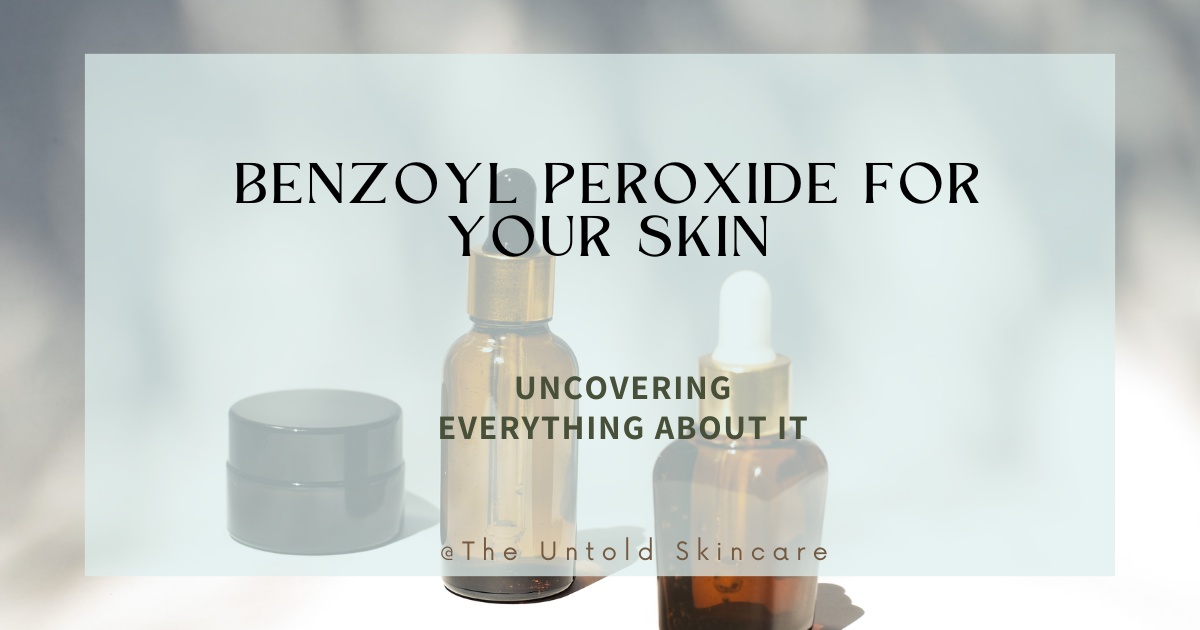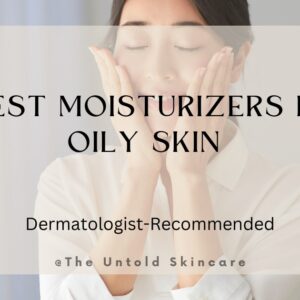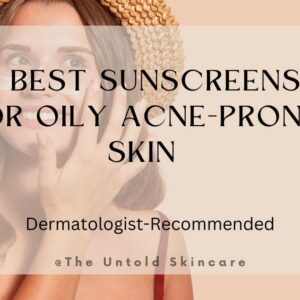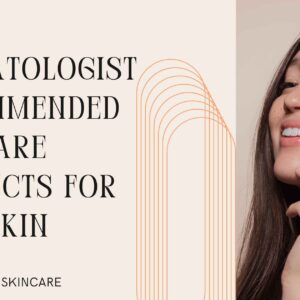What is Benzoyl Peroxide and why do dermatologists consider it as one of the top skincare ingredients of all time?
Benzoyl Peroxide has long been revered as a potent ingredient in the realm of skincare. With its numerous benefits, it has become a staple in the routines of many individuals striving for clear and healthy skin.
But what exactly is Benzoyl Peroxide? Let’s start with that.
At its core, Benzoyl Peroxide is an organic compound that belongs to the peroxide family, mostly known for their anti-microbial properties.
It is widely recognized for its antibacterial properties, making it an effective treatment for various types of acne including whiteheads, blackheads, pustules, and cysts.
When applied topically, it penetrates the skin and works by reducing the presence of acne-causing bacteria, unclogging pores, and reducing excess oil production.
One of the primary benefits of Benzoyl Peroxide is its ability to target and eliminate the root cause of acne. By effectively killing the bacteria that thrive in the skin’s pores, it helps to prevent the formation of new pimples and reduces the frequency and severity of existing breakouts.
This is the reason why it has become the most popular skincare ingredient for treating acne.
How Does Benzoyl Peroxide Work? Let’s Understand The Mechanism
Benzoyl peroxide works as an effective treatment for acne by employing several mechanisms to combat the factors that contribute to acne development.
Benzoyl Peroxide releases oxygen radicals (oxygen molecules with unpaired electrons) when it comes into contact with skin and reacts with the skin’s natural oils. These oxygen radicals are highly reactive and can readily participate in chemical reactions.
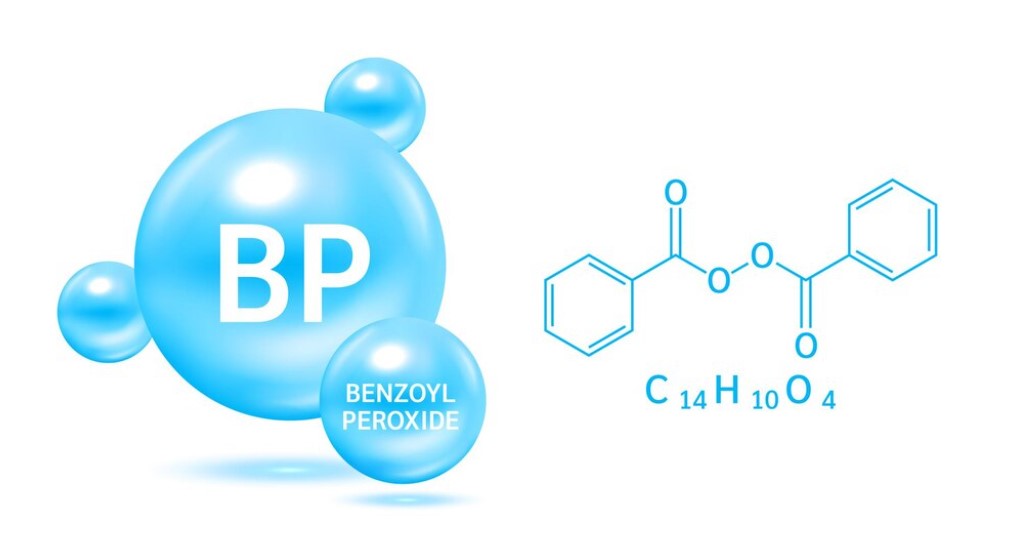
When these oxygen radicals encounter Propionibacterium acnes (P. acnes) bacteria, they can interact with various cellular components, including lipids (fats) in the bacterial cell membranes and proteins inside the bacterial cells.
This damages the integrity of the cell membrane, making it more permeable and disrupting its ability to function as a barrier.
Oxygen radicals can also damage proteins within the bacterial cells. The cumulative damage to the cell membrane and internal structures can be lethal to the P. acnes bacteria.
As the bacterial cells are unable to maintain their structural integrity and normal functions, they may eventually rupture or undergo programmed cell death (apoptosis).
By eradicating this bacteria, benzoyl peroxide helps to reduce inflammation, redness, and the formation of new acne lesions.
Furthermore, benzoyl peroxide is effective in unclogging pores by removing excess oil, dead skin cells, and other impurities. Because of its mild keratolytic effect, it helps to loosen and remove the outer layer of the skin, facilitating the shedding of dead skin cells and preventing them from clogging the pores.
Who Should Use It?
Benzoyl peroxide is generally recommended for individuals who are dealing with acne, particularly those with mild to moderate acne. It can be an effective treatment for various types of acne lesions, including pustules, and cysts.
Individuals with oily skin are more prone to developing clogged pores and acne. Benzoyl peroxide can help regulate oil production and keep pores clear. So, particularly people with oily and acne-prone skin should use it.
It can be used by both teenagers and adults but children below the age of 15 are recommended not to use it.
The Benefits of Benzoyl Peroxide
Benzoyl Peroxide offers a range of benefits that can help achieve clearer, healthier-looking skin.
As discussed earlier, the key benefit of Benzoyl Peroxide is its ability to effectively combat acne-causing bacteria. It works by penetrating deep into the pores and killing the bacteria responsible for breakouts.
Benzoyl peroxide has mild exfoliating properties. It helps to remove dead skin cells from the surface of the skin. This action can prevent clogged pores and promote healthier skin.
While benzoyl peroxide is not primarily an anti-inflammatory medication, its antibacterial action can indirectly help reduce inflammation associated with acne. By reducing the population of P. acnes bacteria, it can minimize the inflammatory response.
It can also be used to treat folliculitis, which is an inflammation of hair follicles often caused by bacteria.
The Side Effects of Benzoyl Peroxide
Although generally safe for use, some individuals may experience certain side effects while using benzoyl peroxide.
Benzoyl peroxide can be drying to some people. It can cause dryness, flakiness, and peeling, especially when first starting treatment or when using higher concentrations. Some individuals may experience redness, itching, burning, or a stinging sensation at the application site.
Benzoyl peroxide also makes your skin more sensitive to UV radiation. So, you should never skip sunscreen while going outside when you are using benzoyl peroxide.
While rare, some people may be allergic to benzoyl peroxide and can experience allergic reactions such as itching, hives, rash, or swelling. If you experience any of these symptoms, discontinue use and seek medical attention.
Benzoyl peroxide has a bleaching effect and can lighten the color of hair and fabrics. Be cautious when using it to avoid contact with clothing and towels.
The Different Forms And Formulations of Benzoyl Peroxide
Benzoyl peroxide is available in various forms and formulations to suit different preferences and skin types. Here are some common forms of benzoyl peroxide:
Creams: Cream formulations of benzoyl peroxide are thicker and often more hydrating. They can be suitable for individuals with drier or sensitive skin. Creams are typically available in different concentrations, ranging from 2.5% to 10% or higher.
Gels: Gel formulations of benzoyl peroxide tend to be lighter and less moisturizing than creams. They are often preferred by individuals with oilier skin. Benzoyl peroxide gels are available in different strengths, including 2.5%, 5%, and 10%.
Lotions: Lotions provide a balance between creams and gels in terms of texture and hydration. They can be suitable for various skin types, including combination skin. Benzoyl peroxide lotions are available in different concentrations.
Washes: Benzoyl peroxide washes are cleansers that contain benzoyl peroxide as an active ingredient. They are designed for daily use and can be a convenient way to incorporate benzoyl peroxide into your skincare routine. They come in various strengths and can be used on the face, chest, and back.

Although you can pick any form of benzoyl peroxide based on your skin type and your convenience, the benzoyl peroxide face wash is considered a better option as it is much gentler and highly effective as well.
Because face washes are rinsed off, there’s a lower risk of overusing benzoyl peroxide, which can occur with leave-on products like creams or gels. Also, some research has shown that the leave-on products of benzoyl peroxide are more associated with its side effects than the washes.
Benefits of Benzoyl Peroxide Face Wash:
- Allows even distribution across the affected areas.
- Less contact time with skin, causing little to no dryness.
- Gentler than any other product type.
- Lower risk of overuse.
What is the Recommended Concentration of Benzoyl Peroxide?
Benzoyl peroxide is available in various strengths, typically ranging from 2.5% to 10%. The recommended concentration of benzoyl peroxide can vary depending on the severity of your acne and your skin’s sensitivity.
A lower concentration of 2.5% is often recommended for people with sensitive or dry skin or those who are just starting to use benzoyl peroxide. It can be effective in treating mild to moderate acne while minimizing the risk of excessive dryness and irritation.
5% concentration is commonly used and is effective for many people with moderate acne. It strikes a balance between effectiveness and potential side effects.
10% concentration is typically recommended for people with slightly severe acne and less sensitive skin. These products can be more drying and may cause more skin irritation, so they should be used with caution and preferably under the guidance of a healthcare provider.
How Often to Use it?
If you’re new to benzoyl peroxide or have sensitive skin, begin with a lower concentration (2.5% or 5%) and use it once a day or every other day to allow your skin to acclimate.
If your skin tolerates it well, you can gradually increase the frequency of use to twice daily. However, for some people, once a day or every other day may be sufficient.
Pay close attention to how your skin reacts. If you notice excessive dryness, redness, or irritation, reduce the frequency or concentration of benzoyl peroxide.
What Not to Mix With Benzoyl Peroxide?
Benzoyl peroxide is a potent acne treatment, but it can interact negatively with certain other products or substances.
Here’s a list of what not to mix or use in conjunction with benzoyl peroxide:
Benzoyl Peroxide and Retinoids
Avoid using benzoyl peroxide at the same time as topical retinoids, such as retinol, tretinoin or adapalene, unless specifically directed by a healthcare professional. These medications can enhance the potential for skin irritation when used together.
If prescribed both, use them on alternate days.
Benzoyl Peroxide and Salicylic Acid
While some people do use both benzoyl peroxide and salicylic acid in their skincare routines, it can be more likely to cause irritation, particularly in individuals with sensitive skin. So, it is better not to mix them.
If you decide to use both, consider applying them at different times of the day or on alternate days.
Benzoyl Peroxide and Hydroquinone
Combining these two components may cause a chemical reaction that could result in the development of compounds with a dark color on the skin.
Both hydroquinone and benzoyl peroxide have the potential to irritate the skin. Combining them can raise the chance of skin irritants including burning, stinging, peeling, or redness.
Can Benzoyl Peroxide be Used for Scalp?
Numerous research studies have demonstrated the potency of benzoyl peroxide shampoo in the treatment of scalp acne and dandruff.
The question of whether you may use it on your scalp is controversial, though.
Its reaction to your scalp is unpredictable because some people may benefit from it while others may be harmed.
Benzoyl peroxide can bleach your hair. If it comes into contact with your hair on the scalp, it can potentially lighten the hair color or create uneven discoloration, which may not be desirable.
If you have sensitive scalp, it can be harsh and drying, and using it on your scalp may lead to irritation, redness, and excessive dryness.
So, here is the bottomline: using benzoyl peroxide on the scalp without professional guidance is not recommended.
Benzoyl Peroxide as Spot Treatment
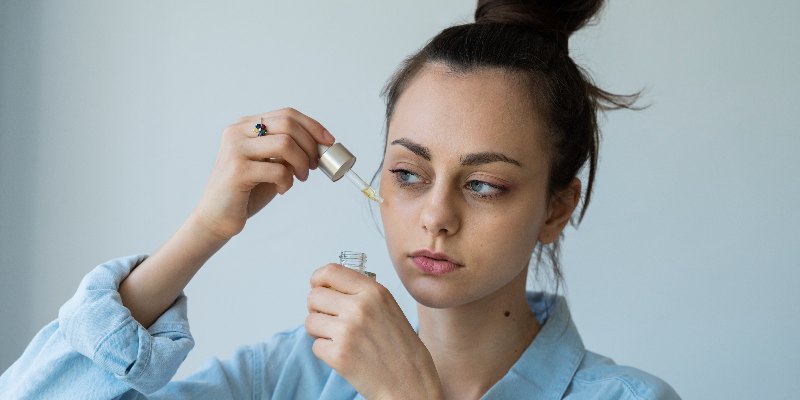
Benzoyl peroxide can be used as a spot treatment for individual acne lesions or pimples rather than applying it to the entire face or affected area.
Using benzoyl peroxide as a spot treatment can be effective in targeting specific breakouts while minimizing potential dryness and irritation to surrounding skin. It can be the best method for people with sensitive skin to incorporate benzoyl peroxide into their skincare routine.
When Benzoyl Peroxide Doesn’t Work?
Benzoyl peroxide is most effective for treating inflammatory acne, such as papules and pustules (red, swollen, and pus-filled pimples). It may not work for non-inflammatory acne, like blackheads and whiteheads.
Acne can be influenced by various factors, including hormonal imbalances, genetics, diet, and lifestyle. If these underlying factors are not addressed, benzoyl peroxide may not provide the intended results.
Another key thing is that benzoyl peroxide is generally more effective for mild to moderate acne. For severe acne cases, more aggressive treatments may be necessary, including prescription medications like oral antibiotics, oral contraceptives, or isotretinoin (Accutane).
Before Vs. After Effects of Benzoyl Peroxide: What to Expect?
With consistent use of benzoyl peroxide, you can expect a reduction in the number and severity of acne breakouts. Pimples and other acne lesions may diminish or clear up. The redness and inflammation associated with acne should decrease, resulting in a calmer and less irritated complexion.
The before vs. after effects of benzoyl peroxide on the skin can also be visible in skin texture. Over time, your skin may become smoother and more even in texture as the exfoliating properties of benzoyl peroxide help remove dead skin cells.
Benzoyl peroxide does not directly treat acne scars, but by preventing new breakouts, it can indirectly help reduce the risk of additional scarring.
How Long Does Benzoyl Peroxide Take to Work?
The effectiveness and the time it takes to work can vary from person to person and depend on several factors, including the severity of the acne, the formulation of the product, and how consistently it is used.
In general, you may start to see some improvement in your acne within a few weeks of using benzoyl peroxide. However, it can take up to 2-3 months of consistent use to see significant results.
Precautions to Take While Using Benzoyl Peroxide
To minimize potential side effects and maximize the benefits of benzoyl peroxide, it is important to follow proper usage guidelines. Start with a lower concentration and gradually increase as tolerated. Apply a thin layer to cleansed and dry skin, focusing on the affected areas. Avoid contact with eyes, lips, and open wounds.
It is also recommended to use a moisturizer to combat dryness and apply sunscreen during the day as benzoyl peroxide can increase skin sensitivity to the sun.
Frequently Asked Questions
1. Is benzoyl peroxide bad for your skin?
No, it’s not. Benzoyl peroxide is one of the most potent skincare ingredients in treating acne. So, until you are using it properly, it is quite safe to use it and is not bad for your skin.
2. Can benzoyl peroxide bleach skin?
Yes, but in very rare cases. If you have extremely sensitive skin or you are using it in higher concentration than recommended, benzoyl peroxide can slightly bleach your skin.
3. How to use Clindamycin and Benzoyl Peroxide together?
The most effective way of using clindamycin and benzoyl peroxide together is to use benzoyl peroxide as a cleanser and clindamycin as a gel or lotion. Wash your face with a gentle benzoyl peroxide cleanser and apply a thin layer of clindamycin gel or lotion to the affected parts of the skin.
4. How does Benzoyl peroxide help with acne?
Benzoyl peroxide helps with acne in multiple ways. Its antimicrobial property helps to kill acne-causing bacteria and its mild exfoliating property helps to unclog pores by removing dead skin cells and excess oil. It also reduces the redness and swelling associated with inflammatory acne lesions such as papules and pustules
5. Can Benzoyl Peroxide be used for sensitive skin?
Benzoyl peroxide can be used for sensitive skin, but it should be used cautiously and in lower concentrations to minimize the risk of irritation. People with sensitive skin may be more prone to experiencing dryness, redness, and irritation when using benzoyl peroxide, so it’s essential to choose the right product and follow the guidelines. It is recommended for people with sensitive skin to use benzoyl peroxide as a spot treatment to reduce the side effects.
6. Can Benzoyl Peroxide be used for skin lightening?
Benzoyl peroxide is not typically used for skin lightening purposes. Its primary use is to treat acne. For skin lightening, there are other skincare ingredients specially designed for it such as kojic acid, alpha arbutin, retinol, and many more.

